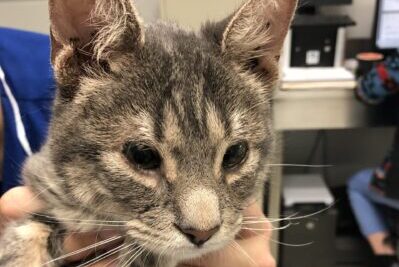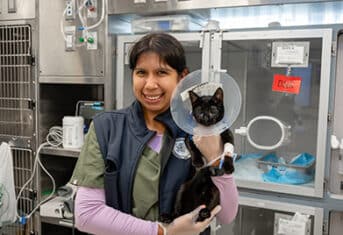Orange, Crème or Calico?

Orange, Crème or Calico?
A visitor to The Animal Medical Center's Facebook page wrote us to ask if a regular calico cat and a dilute (pale) calico cat could come from the same litter. Coat color in cats is controlled by a complex set of genes. Even though genetics are not everyone’s cup of tea, it is common knowledge that cats with calico or tortoise shell coats are usually, but not always female. So, how does this happen and what is the genetic mechanism for dilute calico coat color?
Animals have two types of chromosomes, the autosomes and two other specialized chromosomes, which determine gender. Animals, including us, get one from each parent. If you have two X chromosomes you are female; an X and a Y you are male. The gene for orange is found on the X chromosome. Since males have only one X chromosome they are either black or orange indicating the presence or absence of the orange gene. With their two X chromosomes, females can have coats with both orange and black (i.e. calico or tortoise shell) at the same time. If you find a male calico cat, you have found a rare cat indeed. Only 1:3000 male cats are calico and they have a genetic disorder where they have two X chromosomes giving them the black and orange coat color and one Y chromosome making them male.
A mutation called the Maltese dilution mutation is responsible for making a dilute coat color. This gene requires two copies in a single individual to make a dilute coat color. A gene requiring two copies in a single individual to express a trait is called recessive. If cats carry two copies of the dilution mutation orange becomes crème or yellow and black becomes blue or gray. The mutation causes the melanin pigment granules to be enlarged and unevenly distributed in the hair shaft, resulting in the dilute coloration of the coat. Incidentally, the Maltese dilution mutation is the one responsible for the coat color of a blue point Siamese which is the dilute form of a sealpoint Siamese coat. To see beautiful cats with the Siamese cat coat color variations, visit the National Siamese Cat Club website.
To answer the Facebook reader’s question, yes, female kittens in the same litter could be both dilute and non-dilute calicos. The dilute would carry two copies of the mutated Maltese gene and both a black and orange gene on their two X chromosomes. The non-dilute would have one or no Maltese mutated genes. For more detailed genetic information about feline coat color or to have genetic testing performed on your cat to determine coat color go to the UC Davis Veterinary Genetics Laboratory website.
This blog may also be found in the “Tales from the Pet Clinic” blog from WebMD.
________________________________________________
For over a century, The Animal Medical Center has been a national leader in animal health care, known for its expertise, innovation and success in providing routine, specialty and emergency medical care for companion animals. Thanks in part to the enduring generosity of donors, The AMC is also known for its outstanding teaching, research and compassionate community funds. Please help us to continue these efforts. Send your contribution to: The Animal Medical Center, 510 East 62nd Street, New York, NY 10065. For more information, visit www.amcny.org. To make an appointment, please call 212.838.7053.




































